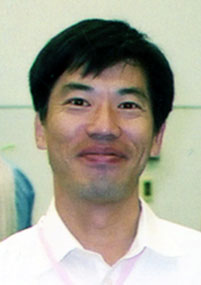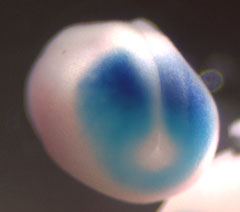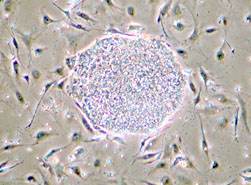

 (left panel) In situ hybridization of two T-box genes: Tbx6 (turquoise) and Tbx6r (dark blue) in the neurula embryo (posterior view). Tbx6r-expressing area is confined to dorsolateral positions and entirely included
in the wider Tbx6-expressing area around the blastopore.
(left panel) In situ hybridization of two T-box genes: Tbx6 (turquoise) and Tbx6r (dark blue) in the neurula embryo (posterior view). Tbx6r-expressing area is confined to dorsolateral positions and entirely included
in the wider Tbx6-expressing area around the blastopore.
As for metamerism in somitogenesis, Tbx6 triggers transctiptions of bowline and ledgerline, two counterparts of mouse ripply family of transctiption factors. These are involved in the formation of
repeated patterns, whereas ledgerline suppresses transctiption of tbx6 in cooperation with a co-repressor Groucho in a negative feedback manner,
restricting the expression of Tbx6 only in the most posterior part of mesoderm.
 Another subject of study is cell differentiation of mammalian pleuripotent stem cells. This work is operated in collaboration with prof. Asashima (formerly
in Tokyo Univ., now in AIST, National Institute of Advanced Industrial
Science and Technology in Tsukuba). Ongoing studies include the differentiation
of neural crest cells from mouse ES cells in a serum- or feeder layer-free conditions.
Another subject of study is cell differentiation of mammalian pleuripotent stem cells. This work is operated in collaboration with prof. Asashima (formerly
in Tokyo Univ., now in AIST, National Institute of Advanced Industrial
Science and Technology in Tsukuba). Ongoing studies include the differentiation
of neural crest cells from mouse ES cells in a serum- or feeder layer-free conditions.
< Recent research themes >
------ Recent Publishing ------
1) Aihara Y, Hayashi Y, Hirata M, Ariki N, Shibata S, Nagoshi N, Nakanishi
M, Ohnuma K, Warashina M, Michiue T,
Uchiyama H, Okano H, Asashima M and Furue MK
Induction of neural crest cells from mouse embryonic stem cells in a
serum-free monolayer culture.
Int. J. Dev. Biol., 54, 1287-1294, 2010.
2) Konno, M.,, Hamazaki, T. S., Fukuda, S., Tokuhara, M., Uchiyama, H., Okazawa, H., Okochi, H., Asashima, M.
Efficiently Differentiating Vascular Endothelial Cells from Adipose
Tissue Derived Mesenchymal Stem Cells in Serum-Free Culture.
Biochem. Biophys. Res. Commun., 400, 461-465, 2010.
3) Tazumi, S., Yabe, S., and Uchiyama, H.
Paraxial T-box genes, Tbx6 and Tbx1, are required for cranial chondrogenesis
and myogenesis.
Devl. Biol., in press.
Accession number of the partial cDNA of X. laevis pcdh18: AB573177
4) Kawsar, S.M.A., R. Matsumoto, Y. Fujii, H. Yasumitsu, H. Uchiyama, M. Hosono, K. Nitta, J. Hamako, T. Matsui, N. Kojima, and Y. Ozeki.
Glycan-binding profile and cell adhesion activity of American bullfrog
(Rana catesbeiana) oocyte galectin-1.
Prot. Peptide Lett. 16, 677-684, 2009.
5) Hitachi, K., Danno, H., Tazumi S., Aihara Y., Uchiyama, H., Okabayashi, K., Kondow, A., and Asashima, M.
The Xenopus Bowline/Ripply family proteins negatively regulate the transcriptional
activity of T-box transcription factors.
Int. J. Dev. Biol. 53, 631-639, 2009.
6) Tazumi, S., S. Yabe, J. Yokoyama, Y. Aihara, and H. Uchiyama.
pMesogenin1 and 2 function directly downstream of Xtbx6 in Xenopus somitogenesis
and myogenesis.
Dev. Dyn. 237, 3749-3761, 2008.
Dev. Dyn. 238, issue2, page fvii, DD Artpix, 2009
Accession number of pMesogenin2 genomic DNA: AB462327.
Accession number of Xtbx6 exon1-exon2 genomic DNA: AB462326.
7) Hitachi K., Danno H., Kondow A., Ohnuma K., Uchiyama H., Ishiura S., Kurisaki A, and Asashima M.
Physical interaction between Tbx6 and mespb is indispensable for the
activation of bowline expression during Xenopus somitogenesis.
Biochem. Biophys. Res. Commun., 372, 607-612, 2008.
8) Hitachi K., Kondow A., Danno H., Inui M., Uchiyama H., and Asashima M.
Tbx6, Thylacine1, and E47 synergistically activate bowline expression
in Xenopus somitogenesis.
Devl. Biol., 313, 816-828, 2008.
9) Yabe S., Tazumi S., Yokoyama J., and Uchiyama, H.
Xtbx6r, a novel T-box gene expressed in the paraxial mesoderm, has anterior
neural-inducing activity.
Int. J. Dev. Biol., 50, 681-689, 2006.
Accession number of Xtbx6r cDNA: AB284536
10) Murakami R., Okumura T., and Uchiyama H.
GATA factors as key regulatory molecule in the development of Drosophila
endoderm.
Dev. Growth Differ. 47, 581-589, 2005.
12) Uchiyama H., T. Kobayashi, A. Yamashita, S. Ohno and S. Yabe.
Corrigendum: Cloning and characterization of the T-box gene Tbx6 in Xenopus laevis.
Develop Growth Differ. 44, 95-96, 2002.
Uchiyama, H., T.Kobayashi,A.Yamashita,S. Ohno, and S. Yabe.
Cloning and characterization of a T-box gene Tbx6 in Xenopus laevis.
Develop. Growth Differ. 43, 657-669, 2001.
Accession number of Xtbx6 cDNA: AB091393
13) Uchiyama, H., A. Koda, S. Komazaki, M. Oyama, and S. Kikuyama.
Occurrence of immunoreactive activin/inhibin βB in thyrotropes and gonadotropes
in the bullfrog pituitary: possible paracrine/autocrine effects of activin
B on gonadotropin secretion.
Gen. Comp. Endocrinol. 118, 68-76 (2000).
14) Koda A., K. Yamamoto, H. Uchiyama, H. Vaudry, and S. Kikuyama.
Effect of activin A and follistatin on the release of pituitary hormones
in the bullfrog Rana Catesbeiana.
Zool. Sci. 17, 971-975 (2000)
15) Yamamoto T., S. Iemura, S. Takagi, H. Uchiyama, S. Shimasaki, H. Sugino and N. Ueno.
Direct binding of follistatin to BMPs inhibits ventral and epidermal cell fates in early Xenopus embryo.
Proc. Natl. Acad. Sci. USA 95, 9337-9342 (1998).